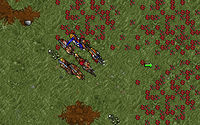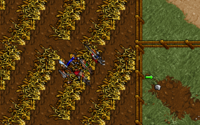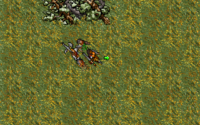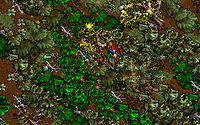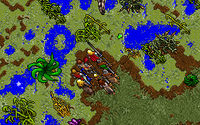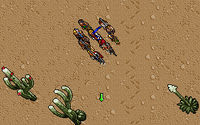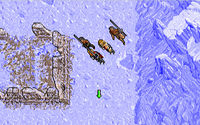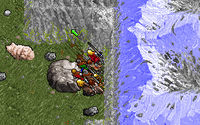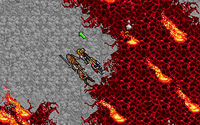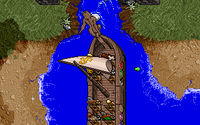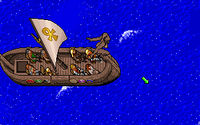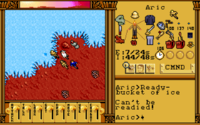Terrain
When traveling through the lands, it is important for adventurers to be familiar with the different kinds of terrain. Each comes with its own advantages and disadvantages, so what follows is an overview of the various types of terrain to be found throughout Sosaria, Britannia, and elsewhere.
Terrain of the Land[edit]
| “ | TERRAIN CONSIDERATIONS. Devote considerable time to the study of the fields of combat. Locate defensible positions for thy party, making sure to maintain an avenue of escape should the battle go badly. Remember our heritage! A few valiant fighters strategically placed in a narrow rocky pass can stand off an army numbered in the thousands. – from The History of Britannia (Ultima IV)
|
|---|
Grassland[edit]
Vast grasslands such as the High Steppes, the isle of New Magincia or bigger stretches of the southern part of Britannia’s main continent pose little to no hinderance or threat to the adventurer. Dangers are far and few between and early to see.
Grasslands are often home to herds of wild horses, sheep and cows, who use these lands to still their hunger. Often, huge stretches of farmland cover this type of terrain, as seen below.
In Ultima III, patches of seemingly-benign grass surrounding Exodus’ castle were actually capable of attacking any intruders.
| “ | No problems moving on grass, but don’t expect it to save you from starvation. Your character is assumed to be humanoid, not bovine. – from The Second Age of Darkness (Ultima II)
|
|---|
| “ | The smoothest and easiest to travel on, the lush grass of Britannia serves to fatten its herds. One may be pass here with any impediment. – from The History of Britannia (Ultima IV)
|
|---|
| “ | The largest portion of Britannia is grassland. Vast rich green grasslands and fertile farming land stretch the vision and fill the heart with promise. For travelers, grasslands are fast and easy going. Although grasslands afford no cover against the hostile creatures that roam them, they enable thee to see danger approaching and prepare for it. – from The Book of Lore (Ultima V)
|
|---|
Fields[edit]
The vast farmlands of Britannia are easy to navigate once one has passed the fence surrounding them. However, farmers do not like to see anyone carelessly trampling through their future harvest and therefore make sure to keep unwanted visitors out. Also, the unasked harvesting of the crops can easily be seen as stealing and thus should not be done.
Fields are often home to small wildlife like mice, rabbits and other harmless vermin, which only is a danger to the crops.
Fields were first seen in Ultima V and since then became a familiar sight in Britannia and other worlds.
| “ | Vast rich green grasslands and fertile farming land stretch the vision and fill the heart with promise. – from The Book of Lore (Ultima V)
|
|---|
Brush[edit]
The vegetation of the brush is much denser than that of the grassland. The grass is here often as high as half a man (sometimes even higher) and low scrub growth and bushes add to the terrain, making travel through it more difficult, slowing down the adventurer. If it is possible, the brush should be avoided so that the goal can be reached with no loss of time.
The brush makes it more difficult to spot foes, and it is home to the smaller wildlife and beasts that can prove troublesome, like foxes, gremlins and tangle vines. Thus, caution is the best advice to follow when moving through the brush.
The brush first appeared in Ultima IV.
| “ | Low scrub growth and bushes will hinder thy progress, permitting thy party to move but at three quarters of thy normal speed. Fine tinder for campfires may be found at the base of larger scrubs. – from The History of Britannia (Ultima IV)
|
|---|
| “ | In the brush, seas of tall grass and scrubby shrubs, everything is as visible and as vulnerable as on the grasslands; only the going is slower and tougher. There is no advantage to traveling through brush over grasslands, unless thou doth need to reach a point within it or it is well out of thy way to circumvent it. – from The Book of Lore (Ultima V)
|
|---|
Forest[edit]
Unlike the grassland and the brush with the occasional, or small group of trees, a forest like the Deep Forest or Spiritwood covers big areas with dense growth of tall trees. While beautiful looking, it has its drawbacks. This density of the growth not only seriously hinders visibility, but also slows down the adventurer a lot. Travel through the wood therefore should be avoided, if possible, especially because of the dangers that lurk within.
Aggressive reapers like to camouflage themselves as harmless trees until striking. Mongbats, bears, wolves and headless also call the forest their home, and react aggressively towards intruders. At least one peaceful inhabitant, the so-called "king of the forests," is the deer, but even these normally-docile creatures will fight back if attacked.
Ultima I was the only installment in the series that had hostiles that were completely confined to and hidden within the forests (archers and trents). Ultima III was the first time that forested areas served to block line-of-sight, and not until Ultima IV did they hinder movement.
| “ | Sometimes there are more monsters in forests, hiding behind trees. But they’re pretty trees and give nice shade. – from The Second Age of Darkness (Ultima II)
|
|---|
| “ | The going is slow through dense woods, with thy speed cut fully in half. The oak so dearly loved by the Druids predominates here, along with healthy growths of Ash and Beech. There is quite a lack of visibility in the forest regions. – from The History of Britannia (Ultima IV)
|
|---|
| “ | Forests cover nearly all of northwest Britannia. The cool, redolent softness of the leaf-covered earth and the sweet air of the deep forests have enchanted many a traveler into a false sense of well-being in one of the most treacherous terrains. Dense, dark and mysterious, the forests are haven to all sorts of creatures. Nor is the forest kind, for it allows no warning; a foe might be upon thee to quickly for thee to react. – from The Book of Lore (Ultima V)
|
|---|
Swamp[edit]
Swamp areas like the Bloody Plains and Fens of the Dead are very dangerous. The muddy and soft ground slows down the adventurer seriously, while the muddy, contaminated water is infested with small vermin that can infect the traveler with the worst diseases and poisons, and can only be held back by wearing swamp boots. The deeper water pits are completely impassable.
On top of that, swamps are home to a number of dangerous wildlife and monsters. Alligators, greer plants, insect swarms, slime, rotworms and corpsers are frighteningly common around swamps. Thus avoid the swamp, if possible.
The toxic swamps first sprang up when Minax corrupted the timestream in Ultima II, damaging the health only of those brave (or foolhardy) enough to traverse them - and most enemies knew better than to do so. Swamps disappeared suddenly with the Enchantress' death, but reappeared in various locations across Britannia in Ultima IV as soft and noxious terrain that could poison passers-by until cured. In Ultima V, horses would refuse to bear their riders across swampland.
For whatever reason, the patches of swamp that could be found in the valley of Eodon were not toxic, or even a real hindrance, to travelers.
| “ | You’ll have trouble making it through a swamp if you’re low on hit points. You lose points with every step. – from The Second Age of Darkness (Ultima II)
|
|---|
| “ | The marshes and fens are particularly treacherous and should be avoided at all costs. While progress is only slowed to half one’s normal pace by the muck underfoot, the marshes give off poisonous gases which can severely harm members of the party. – from The History of Britannia (Ultima IV)
|
|---|
| “ | Swamps are generally poisonous, yet some life-giving herbs grow nowhere else. Some use the deadly mire as fortress against intrusion, for even monsters dislike venturing into the putrid muck. At least, some monsters dislike it; there are rumors of rare and strange monsters that thrive on the swamps and use them to devour their victims. Besides the toxicity, slogging through the slime and hip-deep ooze of the swamps is an extremely slow business. – from The Book of Lore (Ultima V)
|
|---|
Desert[edit]
Travel in the desert of the Drylands is dangerous. While there is no lack of visibility (after all, there is next to no vegetation), the intense heat and lack of moisture in the air will waylay travellers by other means. Another problem is that the heat causes a higher demand on provisions, which will be drained faster, and mirages tend to confuse the traveler.
Despite being hostile to most forms of life, the desert is home to many living dangers. Sand traps wait for the unwary, while giant scorpions, vultures and snakes roam the desert in search of prey. The mazes within the ant mound are a nightmare all their own.
The deserts came into being when the great drought of the northeast consumed Lake Generosity and created the Drylands, some time prior to Ultima V.
| “ | The deserts of northeastern Britannia are hot, dry, and easy to lose one's way in. Besides all sand looking much like all other sand, the heat is apt to play tricks on the eye, misleading travelers with landmarks that are not really there. – from The Book of Lore (Ultima V)
|
|---|
Tundra[edit]
Tundra – such as the Northern Regions of the Serpent Isle – are areas close to the poles where the temperatures are always below freezing and which are covered with ice and snow. Visibility is a problem not because of vegetation, but because of the snow seeming to let everything melt together into one white mess. Besides being seriously slowed down, the adventurer has to invest into warm gear, or death in these cold areas is unavoidable.
There are a few dangers beside the cold as well. Polar bears do not tolerate intruders in their domain, ice hounds roam the empty plains, and wolves are found here, as well as various other animals that have adapted to the cold.
Tundra made its first appearance in Ultima VI.
Hills and Mountains[edit]
Hills and mountains are obstacles unto themselves. Hills merely slow down the adventurer, while mountains like the Serpent's Spine have to be climbed with a grapple, which is both time-consuming and dangerous. The highest peaks are totally impassable. As one might expect, visibility is extremely low in the mountains.
To make matters worse, several dangerous creatures call this terrain their home: harpies, giant spiders, cyclopes, dragons and mongbats to name some of them.
Hilly terrain first appeared in Ultima IV. Mountains have long been a geographical feature, but the art of mountain climbing was virtually unknown until Ultima V.
| “ | The mountains are insurmountable even for the most hardy adventurer. – from The Second Age of Darkness (Ultima II)
|
|---|
| “ | Hilly terrain, much favored by those who raise sheep, will slow thee down considerably, so much so that none but the sure-footed mountain goat can move at more than a snail’s pace.
Mountaineering is not a well-known skill in Britannia, so the mountains are closed to the normal traveler. There is also a lack of visibility over the mountains. – from The History of Britannia (Ultima IV)
|
|---|
| “ | The hills are rustically beautiful, but climbing is time-consuming, even when the rise is gentle.
Mountains are rugged natural barriers for anyone without proper equipment. Beware, however, of certain wild creatures to whom the rocky crags are home. The highest peaks are simply impassable. – from The Book of Lore (Ultima V)
|
|---|
Lava[edit]
While most obstacles are passable by some alternate form of transportation, few of these can withstand the primal-hot fury of lava. Responsible for the creation of new land masses as well as the destruction of whole areas and man-made constructions, lava is most often encountered underground, but is sometimes seen on the surface near active volcanoes. A rare few structures are built using large lava lakes as a measure of added defense, such as the Castle of Fire during the reign of Exodus, and the lava river surrounding Daemon's Crag in Pagan.
A few rare magic items have been created to bypass lava, such as the dragonskin boots and Leather Vest of Flameproof found in the Stygian Abyss, but beware of imitations! In Savage Empire, a modern fire extinguisher could be used to temporarily cool small sections of lava in order to quickly walk over them.
In addition to its inherent danger, some creatures are quite content to make their homes in or near lava, such as lava lizards, daemons, and some dragons.
Lava was first seen in Britannia soon after Exodus rose from the depths in Ultima III.
Tar Pits[edit]
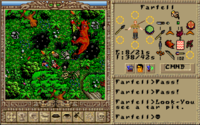
Tar pits were merely an obstacle for the Avatar and his companions, but could prove a literal deathtrap for many of the various other large beasts roaming the primal lands of Eodon. However, if properly harvested, the tar itself could be a key component in the creation of several useful items, including torches and grenades.
Fittingly, tar pits could be encountered only in Worlds of Ultima: The Savage Empire.
| “ | Any tar found in this land will undoubtedly be extremely hot. I would recommend collecting it in a metal container of some kind. A bucket, perhaps. - Dr. Rafkin |
|---|
Waters[edit]
Coast and Shallow Water[edit]
The coast itself can be searched by foot. However, to move through the rivers, lakes and shallow coastal waters, the adventurer has to organize a skiff or raft, since bigger ships cannot enter these waters. Rivers are often obstacles in that bridges or shallow parts have to be found to cross it. Four named rivers are known in Britannia. Britanny River, which marks the eastern limits of Britain and flows into Britanny Bay, the River of Despair, which flows through the High Steppes and ends in Lost Hope Bay, River Maelstrom, which sets the eastern border of Spiritwood and terminates into the sea at the Valorian Isles, and the big Lost River, which begins in Lost Lake and terminates in the northwestern sea.
These coastal areas and shallow waters have dangers of their own. Giant crabs sometimes roam the beaches, while predatory fish and sharks make the waters dangerous. Trolls tend to wait at bridges over rivers.
Coastal and shallow waters were first distinguished from deeper waters in Ultima IV.
Deep Ocean[edit]
Only large, seaworthy vessels like the frigate can explore the ocean; other vessels cannot survive the rough sea. Besides the danger of being lost at sea, the biggest natural dangers are the whirlpools that can eat a ship whole.
Also, the ocean is home to several nasty creatures of the deep. Besides sharks, sea serpents, the Kraken and seahorses will attack intruders, while the nixies have no problem with killing travelers. Also, the threat of pirates is always a given.
| “ | No one in Ultima II knows how to swim except the sea monsters. You can only cross water with a frigate - or pass over it by air. – from The Second Age of Darkness (Ultima II)
|
|---|
| “ | Whether river, lake or sea, shallows are bubbly and impassable for large ships; coastal waters are ripply, deep enough for tall ships, calm enough for small boats; and deep ocean waters are rough, bumpy and dangerous for any but large frigates. – from The Book of Lore (Ultima V)
|
|---|
| “ | Britannia's vast oceans are fed by many rivers and streams that find their origin in mountain lakes and jungle swamps.
There are two major lakes: Lost Lake, in western central Britannia, feeds Lost River, which empties into the delta on the northwestern shore, by means of a network of tiny estuaries; Lock Lake, in north central Britannia, is actually a cutoff inlet from the sea and still has a mix of salt water. Britannia's third lake, the one-time picturesque Lake Generosity, was a casualty of the great drought of the northeast and is now simply a bed of dry sand. Whether river, lake or sea, shallows are bubbly and impassable for large ships; coastal waters are ripply, deep enough for tall ships, calm enough for small boats; and deep ocean waters are rough, bumpy and dangerous for any but large frigates. – from The Book of Lore (Ultima V)
|
|---|
Ice[edit]
On Mars in Martian Dreams, the polar ice caps cover a significant portion of the planet's surface, acting for the most part as an impassable barrier. However, if dealt with properly, it can be melted and put to better use.
In Labyrinth of Worlds, there are several types of ice that may prove troublesome to the adventurer. Cracked ice is unstable and often breaks, dropping you through to ice water underneath. The chance of the ice breaking is a function of one’s Acrobat skill and the amount of weight one is carrying, divided by the maximum amount allowed to carry. The computer checks to see if cracked ice breaks every second you are standing on it.
Some ice is particularly smooth – once stepped onto it, speed or direction can only be altered with difficulty. Not all ice has the same traction.

